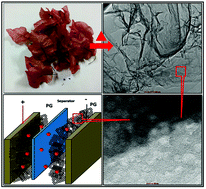Unique perforated graphene derived from Bougainvillea flowers for high-power supercapacitors: a green approach†
Abstract
Herein, we demonstrated a green approach for the synthesis of high surface area (850 m2 g−1) mesoporous perforated graphene (PG) from Bougainvillea flower for the first time using a template free single-step method. The existence of PG was confirmed by XRD, Raman spectroscopy, FESEM, and FETEM. Surprisingly, FETEM clearly showed 5–10 nm perforation on the graphene sheets. More significantly, these mesoporous perforated graphene sheets can be produced in large scale using the present green approach. Considering high surface area and unique perforated graphene architecture, these PGs were studied for supercapacitor applications in detail without any chemical or physical activation. The nanoporosity and high conductivity of PG derived from Bougainvillea flower exhibited excellent supercapacitive performance. According to the supercapacitor study, the synthesized perforated graphene sheets conferred a very high specific capacitance of 458 F g−1 and an energy density of 63.7 Wh kg−1 at the power density of around 273.2 Wh kg−1 in aqueous 1 M Na2SO4. Significantly, the areal capacitance of PG was observed to be very high, i.e. 67.2 mF cm−2. The cyclability study results showed excellent stability of synthesized perforated graphene sheets up to 10 000 cycles. Note that the specific and areal capacitance and the energy density of the synthesized PGs are much higher than the earlier reported values. The high supercapacitive performance may be due to high surface area and mesoporosity of PG. The present approach has a good potential to produce cheaper and high surface area PG. These PGs are good candidates as an anode material in the lithium-ion battery.



 Please wait while we load your content...
Please wait while we load your content...